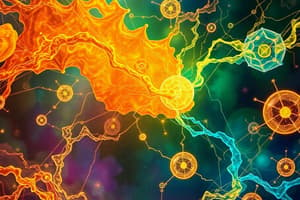Podcast
Questions and Answers
In which regions of the brain is CB1 most commonly found?
In which regions of the brain is CB1 most commonly found?
- Cerebellum and hippocampus (correct)
- Spinal cord and peripheral nervous system
- Basal ganglia and cerebral cortex
- Cerebral cortex and brainstem
What is the primary difference between an endocannabinoid and a cannabinoid?
What is the primary difference between an endocannabinoid and a cannabinoid?
- Endocannabinoids are produced internally, while cannabinoids are produced externally (correct)
- Endocannabinoids are lipid-based, while cannabinoids are water-soluble
- Endocannabinoids are found in the brain, while cannabinoids are found in the body
- Endocannabinoids are synthetic, while cannabinoids are natural
Which neurotransmitters interact with the endocannabinoid system?
Which neurotransmitters interact with the endocannabinoid system?
- Glutamate and aspartate
- Dopamine and serotonin
- GABA and glutamate (correct)
- Acetylcholine and norepinephrine
What is the primary evidence supporting the idea that cannabinoids are addictive?
What is the primary evidence supporting the idea that cannabinoids are addictive?
What is the main idea behind the Gateway Hypothesis?
What is the main idea behind the Gateway Hypothesis?
Study Notes
Cannabinoid Receptors in the Brain
- CB1 receptors are most concentrated in the brain, specifically in regions responsible for motor control, memory, and emotion regulation.
Distribution of CB1 Receptors
- CB1 receptors are commonly found in the hippocampus, cerebellum, basal ganglia, and cerebral cortex, which are involved in:
- Motor coordination and movement
- Memory formation and retrieval
- Emotional processing and response
- Cognitive processing and executive function
Connection to Cannabinoid Effects
- The presence of CB1 receptors in these regions may contribute to the effects of cannabinoids on:
- Motor control and coordination
- Memory and learning
- Emotional state and mood
- Cognitive function and perception
Endocannabinoids vs. Cannabinoids
- Endocannabinoids are naturally produced by the body, whereas cannabinoids are found in the cannabis plant.
- Endocannabinoids are produced by the body to regulate various physiological and cognitive processes.
- Cannabinoids, on the other hand, are introduced into the body through external sources, such as marijuana or cannabis products.
Examples of Endocannabinoids and Cannabinoids
- Examples of endocannabinoids: anandamide, 2-AG (2-arachidonoylglycerol)
- Examples of cannabinoids: THC (tetrahydrocannabinol), CBD (cannabidiol)
Neurotransmitters and the Endocannabinoid System
- The endocannabinoid system interacts with primary neurotransmitters, including:
- GABA (inhibitory neurotransmitter)
- Glutamate (excitatory neurotransmitter)
- Dopamine (reward and motivation)
- Serotonin (mood regulation)
Evidence for Cannabinoid Addiction
- Pieces of evidence supporting the idea of cannabinoid addiction include:
- Withdrawal symptoms in heavy users
- Tolerance development
- Compulsive drug-seeking behavior
- Activation of brain regions involved in reward and motivation
The Gateway Hypothesis
- The Gateway Hypothesis suggests that the use of cannabis (marijuana) increases the likelihood of using other, more dangerous drugs.
- This hypothesis has shaped thinking in terms of marijuana policy, with some arguing that restricting access to cannabis will reduce the risk of addiction to other drugs.
Studying That Suits You
Use AI to generate personalized quizzes and flashcards to suit your learning preferences.
Description
Explore the concentration of cannabinoid receptors in the brain, their regions, and how they connect to the effects of cannabinoids. Learn about endocannabinoids and cannabinoids, and their interactions with primary neurotransmitters.




